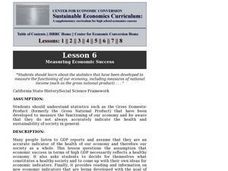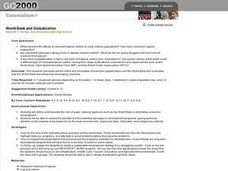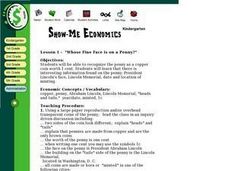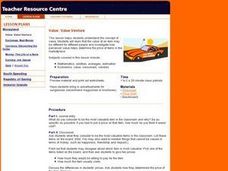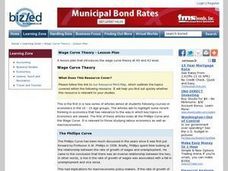Curated OER
Measuring Economic Success
High schoolers are introduced to the Gross Domestic Product and what this number tells us about the economy of the United States. In groups, they discuss what constitutes a healthy society and if the GDP is an accurate representation. ...
Curated OER
Economics Unit I - The Basics
Students describe how demand differs from the quantity demanded, explain what the law of demand states and what demand schedules and demand curves illustrate while studying about economics. Also in retrospect, several writing scenarios...
Curated OER
What is Economics?
Students define economics; Explain the importance and process of making economic choices and decisions; Identify the factors of Production; Determine the goal of entrepreneurship. Students identify and describe the difficulties...
Curated OER
The Assembly Line
Students create an assembly line and build a simple car from LEGO bricks. They explore about the effects of Ford's use of the assembly line, auto financing, and increased wages to make his fortune early in the 20th century.
Curated OER
Literacy as a Force in the World
Students research and compare economic factors and data mining in Nepal. Students look at data to determine how the Nepalese quality of life compares to other countries and predict whether the literacy rate indicates or influences the...
Curated OER
World Bank and Globalization
Pupils define and describe the role of the World Bank in promoting economic development. They assess the benefits and potential damages to development programs. They evaluate how the World Bank has influenced developing countries.
Curated OER
Using the Production Possibilities Frontier
Students identify the purpose of models and why economists use them. Using a graph, they practice reading and plotting points. They are introduced to a production possibilities frontier and draw their own from data supplied to them on...
Curated OER
Teaching Economics Using LUNCH MONEY
Students, after reading the book "Lunch Money" by Andrew Clements, explore money and different saving places. They research different ways in which productivity has increased over the years, they examine products to determine if the...
Curated OER
Rainforests of Madagascar: Role Playing and Decision Making
Students examine reasons for deforestation and become familiar with Madagascar and its culture, while describing biological and abiotic components of a rainforest, and looking at aspects that must be addressed to resolve the issue of...
Curated OER
Show-Me Economics
Third graders distinguish between savings and spending. Students graph out a variety of important Economic concepts/vocabulary. They set up an imaginary job to save money and spend money.
Curated OER
Goods and Services?
Learners distinguish between goods and services, and identify that goods and services are used to satisfy needs and wants. They view illustrations from books to find and chart examples of good and services and make connections that goods...
Curated OER
And Justice for All?
High schoolers explore the history of the environmental justice movement. They examine how discrimination promotes environmental illness in low income communities. Students explain why minority and low income groups have less economic...
Curated OER
Social Studies: Geographic Regions
Third graders create Powerpoint presentations about the five themes of geography in regions of the United States. They focus on the Northeast, Southeast, and Midwest regions. Students use both pictures and words in their shows.
Curated OER
Value Venture
Students examine how the value of an item may be different for different people and investigate how perceived value helps determine the price of items in the marketplace. They list what they consider to be the most valuable items in the...
Curated OER
International Trade
Learners make an inquiry of concepts through the answering of a series of questions that cover governmental controls. The concepts of international trade are covered The exchange rates of trade are used and the elemeents appreciation and...
Curated OER
Interpreting Company Accounts
Students look at the two aspects of interpreting company accounts. They can be closely related to each other. Depreciation is investigated and is interpreted according to the inquiry made. The affect of how accounts are presented is...
Curated OER
Management and Leadership
Pupils undertake the study of leadership theory. The skills of being a leader and manager are covered. There is a comprehensive use of real life examples throughout the lesson.
Curated OER
Business Location
Students consider factors that modern business, in the light of technological and economic changes, might have to consider in decisions to re-locate. The Activity is based around a scenario of a business selling CDs and DVDs to a variety...
Curated OER
Business Analysis and Sales Forecasting - Lesson Plan: 3 x 1 hour lessons
Students view and discuss a PowerPoint presentation (provided as a link on the lesson plan). Students analyze trends and problems bussinesses face in establishing and identifying trends.
Curated OER
Diminishing Returns
Students play an economics game to learn about the law of diminishing returns. The lesson can be used to link to other concepts. The difference of production and productivity is explored.
Curated OER
Market Structure: Oligopolies
Students investigate the structure of oligopolistic markets. The business market is explored in order to make a comparison to accepted theory found in textbooks. An overall picture of the market is then created within the student mind to...
Curated OER
Poverty, Inequality, and Income Distribution
Students come up with a definition of poverty through performing an investigation. The problems of policy makers is addressed with the intention of how poverty can be solved. The problem of poverty is shown to have the capability of...
Curated OER
Wage Curve Theory
Students examine both the Phillips Curve and the Wave Curve theories of economics. They read case studies which have implications for labor economics as well as macroeconomics.
Curated OER
Genetically Modified Crops
Learners recognize the difference between negative and positive externalties. They diagram reasons for market failures pertaining to genetically altered crops.


